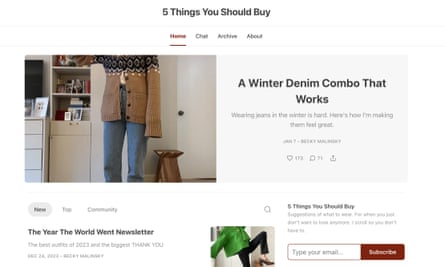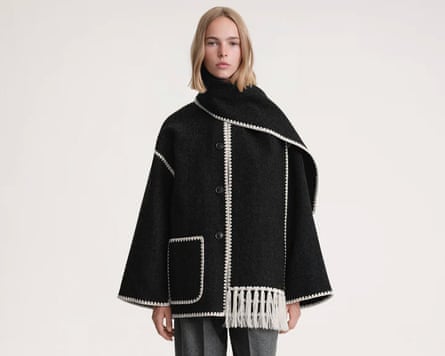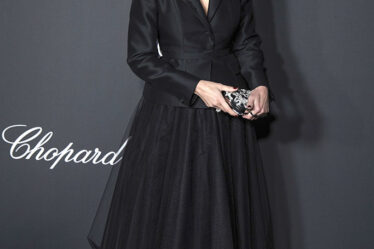
There is plenty of chatter around trends this time of year. What aesthetics will fade away and what will be this year’s version of tomato girl summer. TikTok is already championing “mob wife era”, featuring faux-fur coats, big hair, tennis necklaces and reruns of The Sopranos. Meanwhile, I’ve been thinking about shopping. Specifically, how we shop and the continuous chrysalis of consumerism.
Not long ago, if you wanted to find a new pair of jeans you’d have gone to a physical shop or picked up a fashion magazine. When blogging took off circa 2007, you could browse 36 vaguely different images of someone posing in their favourite pairs. Next came Instagram, which turned bloggers into influencers as they monetised posts, becoming internet sales assistants of sorts.
Now another shopping shift is underway. Substack, an online platform that allows users to send digital newsletters directly to their audience, is changing the way people in-the-know buy clothes. Founded in 2017, the American company quickly became a mecca for well-known writers, novelists and academics covering everything from film to food and science. More recently, however, it’s seen a huge surge in fashion content, with subscriptions in the fashion and beauty category up 80% year-on-year, according to Substack.
A big part of Substack’s appeal is that fashion content on social media platforms such as Instagram and TikTok has become saturated, homogeneous and often so glossy it’s hard to trust. On the flip side, a disingenuous “relatable aesthetic” is also rife. Buying clothing from a link posted by someone who is only promoting it under duress of a paid partnership or ad has started to feel a little … icky.
So to Substack, where former editors and stylists give their shopping recommendations to hundreds and sometimes thousands of subscribers. They have become a new type of personal shopper and sometimes even stylist. Often they’ll answer a subscriber’s specific question. Sometimes they’ll show how to wear a piece in multiple ways. Other times, they provide just a simple styling trick, or lengthy lesson in say clashing textures.
In the newsletter 5 Things You Should Buy, the Wall Street Journal’s former deputy fashion director Becky Malinsky describes herself as “a veteran fashion editor breaking down trends and making shopping easier. I scroll so you don’t have to.”
That’s where the crux of the appeal of these Substacks lies. Who has time to scour the internet searching for that perfect pair of jeans? Much easier to let someone else do the filtering, separating the skinny from the wide leg, and homing in on what’s actually worth spending your money on.

The vintage buyer Subrina Heyink focuses on “how to get dressed”, covering everything from underwear to “holiday dressing for procrastinators and frugality”. Shopping is also the focus of Laura Reilly’s bi-weekly newsletter, Magasin. “Everything on this list is under $250” reads one September issue. “I’m wearing this Toteme top every three days,” reads another.
It’s fascinating to check out what these new adjudicators of shopping buy. And how much they spend. But what’s even more intriguing is the influence they have on their subscribers. Everything from Uniqlo’s crossbody bag to the Toteme scarf coat and High Sport’s kick-flare trousers have become cult items in part due to their endorsement
after newsletter promotion
Of course they are still earning coin from their recommendations – but rather than paid partnerships with brands, most use affiliate links, meaning they earn a small commission from sales driven by their recommendations. Alongside unedited images showing themselves wearing pieces they’ve actually bought with their own money, it feels slightly more authentic than a polished Instagram post. Some such as Reilly are early adopters of the wardrobe-tracking trend, disclosing how much they buy and spend. It’s still promoting consumption, but perhaps, these types of considered purchases can lead to less?
As many consumers mark high street and luxury brands’ weekly marketing emails as spam, these shopping Substacks feel like a systematic shift in the future of retail.
To read the complete version of this newsletter – complete with this week’s trending topics in The Measure and your wardrobe dilemmas solved – subscribe to receive Fashion Statement in your inbox every Thursday.



